Limestone
Biological Process
Required Geological Setting
Occurrence
A kind of sedimentary rocks containing more than 50 % calcium carbonate. Limestone is originated from remains of such organisms composed mainly of calcium carbonate as shellfishes, corals, stromatoporoids, calcareous algae, crinoids, coccolithophorids, and calcareous foraminifera. Limestone is formed in biotic reefs, pelagic marine and shallow marine circumstances, or as tufa and travertine. Reef limestone is originated from biotic reefs. It is reported that dominant organisms in biotic reefs are different in ages; Cambrian archeocyathids, Devonian stromatoporoids-rugose corals, Jurassic to Early Cretaceous stromatoporoids-hexacorallia, Late Cretaceous rudists, Neogene to present hexacorallia. Paleozoic reef limestones frequently contains crinoids and fusulinids, a kind of calcareous foraminifera. Pelagic marine limestones are originated from calcareous sediments deposited on ocean floors above the carbonate compensation depth (CCD). CCD is 4,000-5,000m at low latitude locations and is shallower at higher latitude locations. These calcareous sediments are mainly composed of planktonic calcareous foraminifera and coccolithophorids. Pelagic marine limestone may form thick and large scale strata. Shallow marine limestone contains ooids and few fossils. It is considered that shallow marine limestone was deposited chemically by evaporation of seawater in the shallow marine circumstances, or formd by assistance of bacteria. There are impure limestones containing petroleum, phosphate, manganese, and strontium.

Distribution of limestone described in this site. Yellow zones are accretionary complexes.
Mineral Assemblages
Calcite